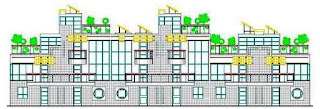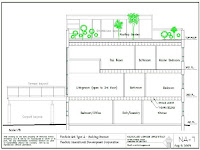


- Allows for multi-generational family living
- Making home ownership more affordable
- It can grow in time
- Offers neighbourly security and assistance
- Facilitates home care for seniors
- Provides adaptability of the living space
- It is ideal for people who need two residences, such as snow birds
- Provides a private outdoor space on the roof
- Has comfortable radiant floor heating, ideal for seniors
- Eliminates most allergens from interior finishes
- Strengthens community neighbourhood spirit
- Potential rental income
- Ground floor may have a separate office for home business
- Low maintenance requirements
- Potential electricity generation
- Growing fruits and vegetables on the roof
- Reduced insurance premiums due to non-combustible construction
- Saving on CMHC mortgage insurance
- Reduced moving costs
- Longer building life span
- Higher resale value
Discussion on Market Trends
The residential market is thirsty for housing that would meet the immediate and long term needs of a growing number of consumers: new home buyers, empty nesters, snow birds, people with special needs, ethnic groups with extended family traditions, etc. First home buyers will have the choice of starting with a small unit and enlarge it later, or partnering and buying a larger unit.
The Solar Flexhouse™ could be of particular interest to seniors and to those who care for them. Each unit can fluctuate between a single family home and a duplex; this allows for independent living.
Thanks to its sustainability and reduced footprint on the land, The Solar Flexhouse™ could also appeal to the environmentally conscious home buyer, not satisfied with the wasteful conventional housing presently available.
An increasing number of elderly people seek more convenient forms of housing, with less space and maintenance and where they can get outside help more easily. Many home owners sell their houses and move into apartments or "trendy" one storey condos. Then, as they become less self-reliant, most move to some form of senior housing that is suitable to their income. Moving is stressful, especially for seniors, but for many it is the only alternative available at the present. The Solar Flexhouse™ offers an ideal home for snow birds. They can fly south in the winter without leaving their house vacant.
As the older generation ages, there is a trend to live with adult children, rather than in nursing homes. The grandparents become part of a larger family; they are cared for and contribute to the wellbeing of all, especially the grandchildren. They can provide free, high quality child care in families where both, or the single parent(s) works.
Accommodating people with disabilities
There is growing awareness for the needs of the physically and mentally challenged. The last few years have brought new building code regulations, active contribution from numerous organizations and broader acceptance by the general public. There is a trend towards integrating people with disabilities into the community. The Solar Flexhouse™ offers a unique solution for making the entire home barrier free, through its stacked storage space which can accommodate an elevator with minimum disruptions and cost.
Increasing number of self-employed
Due to the present "downsizing revolution", the army of small entrepreneurs is growing steadily. To keep overhead costs low, many new self-employed are obliged to use part of their homes to run their businesses. This is a return to the times when many houses, especially on Main Street, had a shop at the ground floor with flats above.
The economic factor
A growing number of people are searching for more affordable housing and new sources of income. The affordability of the Solar Flexhouse™ is achieved in two ways: firstly, the purchaser can start with an initial smaller and lower priced unit and expand it later; secondly, the home itself can become a source of revenues. Also, due to financial restraints, more families are forced to pull back together. Young adults who cannot find work have to live with their parents; parents who could not save for retirement have to live with their children. The rising cost of energy and long-term maintenance is becoming another determinant factor in selecting a home. The Solar Flexhouse™ will have much lower maintenance costs. This is due to the highest energy conservation standards available on the market. And finally, being virtually non-combustible, the Solar Flexhouse™ will secure lower long term insurance premiums, over a longer lifespan than conventional housing.
The social factor
Many social problems, such as crime, juvenile delinquency, child abuse, vandalism, neglect, etc., can be alleviated by creating integrated communities. Staying in one place for a long time creates a sense of belonging and caring. Home ownership strengthens urban communities and can be made affordable with new innovative forms of housing.
Urban & consumer renewal
There is a growing acceptance today of the fact that society cannot afford to let urban sprawl continue. The environmental, economic and social costs are becoming more and more evident. New planning ideas and concepts that focus on better management of resources, especially land and infrastructure, are gaining ground. Infill and higher density residential developments work towards preserving the natural environment and farm land and also revitalizing downtowns. Compact, two/three storey dwelling units can compete effectively with conventional houses. The Solar Flexhouse™ is ideal for creating economically sustainable residential communities.
Environmental awareness
The number of people who are environmentally conscious is growing rapidly. The trend in home buyers’ expectations is towards sustainable housing. By reducing the need for energy and natural resources, The Solar Flexhouse™ will meet and exceed these expectations.
Competitive Edge
FlexHousing™ History
FlexHousing™ means adaptability in time and space to create a "total family" home; the nucleus which grows and changes to accommodate a wide range of needs, across generations; a home which is also seed for neighbourhood community spirit. FlexHousing™ helps people adapt their home to fit their requirements as they change in time, without having to move; this strengthens communities, lowers the need for new housing and reduces the consumption of energy and building materials.
The number of population grows and people’s needs change in time, due to age and life style. This fuels the ever-growing demand for new housing. FlexHousing™ offers people the possibility of adapting their home to fit their requirements as they change, and reduces the need to build new housing. That’s why FlexHousing™ is an essential element of sustainable development, by reducing the need for new residential buildings.
The concept had been promoted by Canada Mortgage and Housing Corporation, starting with its design competition in 1996, in which Nicholas Varias was the national winner. His achievement was announced in the House of Commons of Canada, on April 25, 1997:
“Mr. Joe Fontana (London East, Lib.): Mr. Speaker, it is my pleasure to recognize Mr. Nicholas Varias of London, Ontario as the national winner of Canada Mortgage and Housing's flexhousing design competition… Mr. Varias' winning design reflects CMHC's flexhousing principles of adaptability, accessibility and affordability...”
Subsequently, a model unit was constructed in 1998, on the campus of the National Research Council in Ottawa, at the Canadian Centre for Housing Technology’s InfoCentre.







